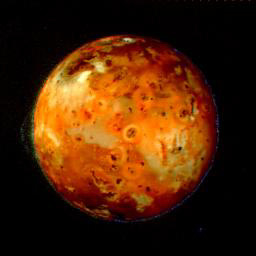This is an image of Io.
Click on image for full size
The Jet Propulsion Laboratory
Io's Atmosphere
There are no clouds and lightning. The atmosphere of Io is very thin and does not remain gravitationally bound to Io for very long. Even so, it has an important impact on the Jupiter system.
Io's atmosphere comes from its volcanoes, then disperses because, as a small moon, Io is not massive enough to have substantial gravity. Portions of the atmosphere may also come from other processes which cause molecules to be extracted from the surface.
Because the atmosphere comes from it's volcanos, the air of Io is made primarily of sulphur.
Once the particles from the atmosphere get into the magnetosphere, they create a donut-shaped cloud of material around Io.
The Galileo spacecraft, in exploring the moons of Jupiter will try to learn more about the atmosphere of Io.
You might also be interested in:
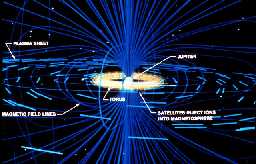
A satellite which has an atmosphere, such as Jupiter's moon Io, will leave a cloud of particles behind as it orbits the planet. Rhea, a body with an icy surface exposed to energetic particles, will have
...more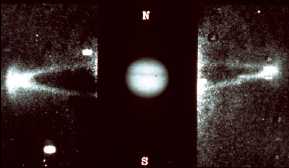
A satellite which has an atmosphere, such as Jupiter's moon Io, and which also is inside a magnetosphere (unlike the Earth's moon), will leave a cloud of particles behind as it orbits the planet. This
...more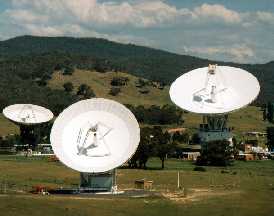
Most forms of life leave evidence behind that they are there. Plants use up carbon dioxide and release oxygen. Some bacteria are known to release nitrogen into the environment. People leave behind smog,
...more
Amalthea was discovered by E Barnard in 1872. Of the 17 moons it is the 3rd closest to Jupiter, with a standoff distance of 181,300 km. Amalthea is about the size of a county or small state, and is just
...more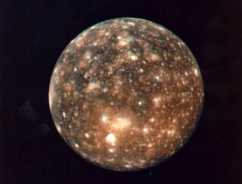
Callisto was first discovered by Galileo in 1610, making it one of the Galilean Satellites. Of the 60 moons it is the 8th closest to Jupiter, with a standoff distance of 1,070,000 km. It is the 2nd largest
...more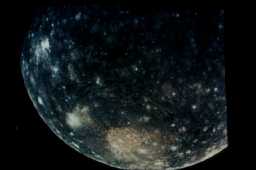
Most of the moons and planets formed by accretion of rocky material and volatiles out of the primitive solar nebula and soon thereafter they differentiated. Measurements by the Galileo spacecraft have
...more
Many examples of the differing types of terrain are shown in this image. In the foreground is a huge impact crater, which extends for almost an entire hemisphere on the surface. This crater may be compared
...more


